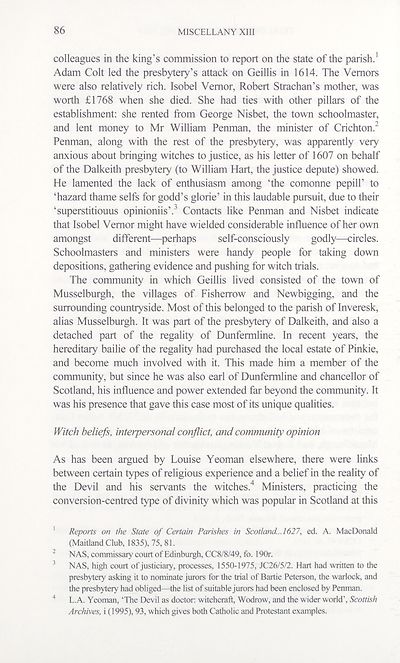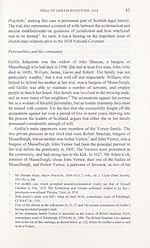Series 5 > Miscellany [of the Scottish History Society] XIII
(101) Page 86
Download files
Complete book:
Individual page:
Thumbnail gallery: Grid view | List view

86
MISCELLANY XIII
colleagues in the king’s commission to report on the state of the parish.1
Adam Colt led the presbytery’s attack on Geillis in 1614. The Vemors
were also relatively rich. Isobel Vemor, Robert Strachan’s mother, was
worth £1768 when she died. She had ties with other pillars of the
establishment: she rented from George Nisbet, the town schoolmaster,
and lent money to Mr William Penman, the minister of Crichton.2
Penman, along with the rest of the presbytery, was apparently very
anxious about bringing witches to justice, as his letter of 1607 on behalf
of the Dalkeith presbytery (to William Hart, the justice depute) showed.
He lamented the lack of enthusiasm among ‘the comonne pepill’ to
‘hazard thame seifs for godd’s glorie’ in this laudable pursuit, due to their
‘superstitiouus opinioniis’.3 Contacts like Penman and Nisbet indicate
that Isobel Vemor might have wielded considerable influence of her own
amongst different—perhaps self-consciously godly—circles.
Schoolmasters and ministers were handy people for taking down
depositions, gathering evidence and pushing for witch trials.
The community in which Geillis lived consisted of the town of
Musselburgh, the villages of Fisherrow and Newbigging, and the
surrounding countryside. Most of this belonged to the parish of Inveresk,
alias Musselburgh. It was part of the presbytery of Dalkeith, and also a
detached part of the regality of Dunfermline. In recent years, the
hereditary bailie of the regality had purchased the local estate of Pinkie,
and become much involved with it. This made him a member of the
community, but since he was also earl of Dunfermline and chancellor of
Scotland, his influence and power extended far beyond the community. It
was his presence that gave this case most of its unique qualities.
Witch beliefs, interpersonal conflict, and community opinion
As has been argued by Louise Yeoman elsewhere, there were links
between certain types of religious experience and a belief in the reality of
the Devil and his servants the witches.4 Ministers, practicing the
conversion-centred type of divinity which was popular in Scotland at this
1 Reports on the State of Certain Parishes in Scotland... 1627, ed. A. MacDonald
(Maitland Club, 1835), 75,81.
2 NAS, commissary court of Edinburgh, CC8/8/49, fo. 190r.
3 NAS, high court of justiciary, processes, 1550-1975, JC26/5/2. Hart had written to the
presbytery asking it to nominate jurors for the trial of Bartie Peterson, the warlock, and
the presbytery had obliged—the list of suitable jurors had been enclosed by Penman.
4 L.A. Yeoman, ‘The Devil as doctor: witchcraft, Wodrow, and the wider world’, Scottish
Archives, i (1995), 93, which gives both Catholic and Protestant examples.
MISCELLANY XIII
colleagues in the king’s commission to report on the state of the parish.1
Adam Colt led the presbytery’s attack on Geillis in 1614. The Vemors
were also relatively rich. Isobel Vemor, Robert Strachan’s mother, was
worth £1768 when she died. She had ties with other pillars of the
establishment: she rented from George Nisbet, the town schoolmaster,
and lent money to Mr William Penman, the minister of Crichton.2
Penman, along with the rest of the presbytery, was apparently very
anxious about bringing witches to justice, as his letter of 1607 on behalf
of the Dalkeith presbytery (to William Hart, the justice depute) showed.
He lamented the lack of enthusiasm among ‘the comonne pepill’ to
‘hazard thame seifs for godd’s glorie’ in this laudable pursuit, due to their
‘superstitiouus opinioniis’.3 Contacts like Penman and Nisbet indicate
that Isobel Vemor might have wielded considerable influence of her own
amongst different—perhaps self-consciously godly—circles.
Schoolmasters and ministers were handy people for taking down
depositions, gathering evidence and pushing for witch trials.
The community in which Geillis lived consisted of the town of
Musselburgh, the villages of Fisherrow and Newbigging, and the
surrounding countryside. Most of this belonged to the parish of Inveresk,
alias Musselburgh. It was part of the presbytery of Dalkeith, and also a
detached part of the regality of Dunfermline. In recent years, the
hereditary bailie of the regality had purchased the local estate of Pinkie,
and become much involved with it. This made him a member of the
community, but since he was also earl of Dunfermline and chancellor of
Scotland, his influence and power extended far beyond the community. It
was his presence that gave this case most of its unique qualities.
Witch beliefs, interpersonal conflict, and community opinion
As has been argued by Louise Yeoman elsewhere, there were links
between certain types of religious experience and a belief in the reality of
the Devil and his servants the witches.4 Ministers, practicing the
conversion-centred type of divinity which was popular in Scotland at this
1 Reports on the State of Certain Parishes in Scotland... 1627, ed. A. MacDonald
(Maitland Club, 1835), 75,81.
2 NAS, commissary court of Edinburgh, CC8/8/49, fo. 190r.
3 NAS, high court of justiciary, processes, 1550-1975, JC26/5/2. Hart had written to the
presbytery asking it to nominate jurors for the trial of Bartie Peterson, the warlock, and
the presbytery had obliged—the list of suitable jurors had been enclosed by Penman.
4 L.A. Yeoman, ‘The Devil as doctor: witchcraft, Wodrow, and the wider world’, Scottish
Archives, i (1995), 93, which gives both Catholic and Protestant examples.
Set display mode to:
![]() Universal Viewer |
Universal Viewer | ![]() Mirador |
Large image | Transcription
Mirador |
Large image | Transcription
Images and transcriptions on this page, including medium image downloads, may be used under the Creative Commons Attribution 4.0 International Licence unless otherwise stated. ![]()
| Scottish History Society volumes > Series 5 > Miscellany [of the Scottish History Society] XIII > (101) Page 86 |
|---|
| Permanent URL | https://digital.nls.uk/127314741 |
|---|
| Description | Over 180 volumes, published by the Scottish History Society, containing original sources on Scotland's history and people. With a wide range of subjects, the books collectively cover all periods from the 12th to 20th centuries, and reflect changing trends in Scottish history. Sources are accompanied by scholarly interpretation, references and bibliographies. Volumes are usually published annually, and more digitised volumes will be added as they become available. |
|---|


